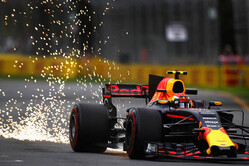


25/03/2017
NEWS STORY
 Mat Coch writes
Mat Coch writes
Lewis Hamilton's pole position lap provided the world with the first opportunity to see the latest generation Formula 1 car being pushed to its absolute limit.
Around the sinuous Albert Park circuit the three-time world champion hustled the Mercedes, recording a time of 1:22.188, sealing pole by more than a quarter of a second from Sebastian Vettel's Ferrari and seemingly establishing himself at the top of the 2017 heap.
It also highlighted a rather inconvenient fact; that despite all the hype and PR mumbo jumbo, the promised increase in speed has failed to materialise.
Behind closed doors paddock insiders are unhappy with the latest generation of cars, which feature unsightly ‘shark fin' and ‘T-wing' solutions.
Broadly speaking they're the only real visible differences a casual observer will notice compared to their 2016 predecessors - only the eagle-eyed would spot the fact the Pirelli tyres are also wider.
Throughout 2016 we were promised aggressive new cars, a statement that was never qualified and has instead seen a wave of ugly ducklings. Perhaps in time they'll bloom into beautiful swans, but under the current regulation set that seems difficult to imagine.
More than the aesthetic aspects however, the numbers simply don't add up. The claims were always for cars that were up to five seconds faster than those from 2016, and changes were made to the Albert Park, among others, to accommodate for the rise in speed.
Admittedly during pre-season testing, Kimi Raikkonen's final day best of 1:18.634 bettered Sebastian Vettel's best from a year earlier by more than four seconds.
That in itself however fails to tell the full story, given by the end of 2016 speeds had already risen in comparison to the start of the year. The four second improvement can therefore likely be halved, making the 2017 spec Formula 1 cars perhaps only two seconds a lap faster in testing - a far cry from the five second improvement we'd been promised.
Pouring more water on that particular fire was the fact Hamilton's pole lap in Australia was only 1.6-seconds faster than his pole position effort from twelve months ago.
"It's a different tyre compound and a different situation," argued McLaren's Eric Boullier when asked if the new ‘aggressive' formula had achieved its goals. "To be honest I don't know.
"We were expecting the car to be faster, and the car was faster in Barcelona, here it's a little bit less."
Conditions for qualifying in 2016 and 2017 in Australia were broadly similar. Track temperature at the start of the session was five degrees warmer, though the air temperature in 2016 was 13 degrees down on this year. These are factors that don't allow for exact side-by-side comparisons, and the warmer temperature wouldn't have helped the turbocharged engines this year, but a 1.6-second advantage is less than half of what was predicted.
According to Haas' Guenther Steiner, that's exactly what he expected to see based on the simulations the American team had run. "They are about where we thought they would be," he responded when asked if lap times were better or worse than the team had predicted in its simulations. "You never know until you get here really.
"You need to live it again because the temperature plays a lot and you cannot simulate for that one. You can simulate, but you don't know where you'll be."
The 1.6-second performance increase could therefore be largely accounted for in the natural evolution of the sport, prompting the awkward question: has this new, aggressive - and no doubt expensive- revamp of the regulations achieved what it claimed, or have we - as Pitpass suggested just two days into pre-season testing - been sold a dummy?
Of course, to form a more accurate picture we must afford the sport an opportunity to prove us wrong, and perhaps the development race will see the pace of cars shoot up dramatically, however on the current evidence one would suggest it has fallen well short of the lofty marker fans had hoped for.
However, a spokesman for a leading team disputed the claim.
"The target was to be 5s quicker than the start of 2015, and Lewis was 4.2s under that pole time," they said. "As Eric said tyres are harder which was a factor that couldn't be calculated at the time.
"But the cars are certainly delivering the expected performance step."
Check out our Saturday gallery from Melbourne, here.